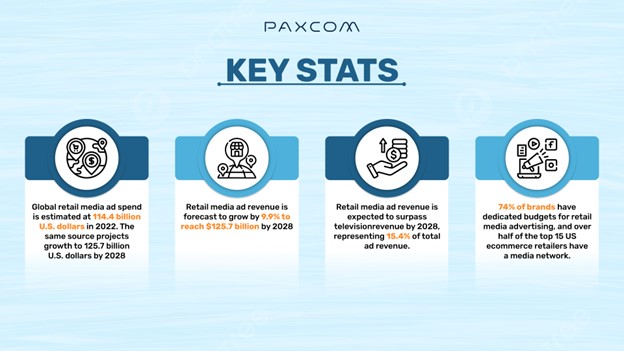In the ever-evolving digital advertising landscape, Retail Media Networks have emerged as a lucrative avenue for retailers to monetize their online presence. This form of advertising involves selling ad space on digital channels such as websites and apps to third-party brands, offering them a platform to connect with a captive audience. While Retail Media Networks have experienced significant growth over the past decade, the dynamics of this space are set to undergo transformative changes.
Table of Contents
The Retail Media Journey So Far
A decade ago, the concept of Retail Media Networks was in its infancy, with the first network paving the way for a burgeoning industry that now boasts over 150 networks globally. These networks succeeded in a fragmented ad-buying landscape by relying on the coattails of retailers’ existing relationships with consumer brands. Still navigating the uncharted territory of retail media, advertisers often approached it in isolation, buying ad space independently of other marketing investments. The boom in e-commerce and the dip in trade promotions further fueled the growth of these networks.
Winds of Change
However, the golden era of unhindered growth for Retail Media Networks is poised for transformation. The next few years will witness heightened competition as new networks launched by value and specialty retailers enter the arena. Expanding ad inventory beyond retailer-owned websites and apps will outpace demand, challenging the status quo. Significantly, advertisers are shifting their approach from viewing retail media as an experimental channel to strategically integrating it into their marketing mix.
In a survey by Bain & Company, 50% of US advertisers expressed an intent to consolidate their spending with a select few retail media networks. Advertisers are setting higher performance standards, pushing networks to deliver more value and measurable outcomes. This shift marks the dawn of the performance era in retail media, where networks must prove their effectiveness in driving sales and providing a compelling return on ad spending.
Clear Winners and Losers
As the competitive landscape intensifies, winners and losers in the retail media will emerge. Longstanding supplier relationships or brand-retailer affiliations no longer bind advertisers. Instead, they will prioritize networks that deliver tangible returns, increase sales, and align seamlessly with their brand strategy. Some leading retail media networks are already capitalizing on this shift, emphasizing the importance of adaptability in this evolving ecosystem.
The Future Growth Trajectory
While challenges lie ahead, the future growth trajectory of retail media remains promising. Projections indicate a robust annual market growth of 12%, reaching approximately $140 billion by 2026. In the US, where spending is expected to grow by 16% annually between 2022 and 2026, retail media is set to become a $100 billion market by 2025. This anticipated revenue surge, coupled with attractive profit margins, positions retail media as a central player in the structural shift within the retail industry.
Key Challenges and Strategies
As retail media transforms, it faces four key challenges that demand resolution:
- Rapid Market Changes: The market is swiftly evolving, with new ad formats and innovations emerging. Retail media networks must navigate this complexity and plan for long-term tech investments.
- New Go-to-Market Playbook: Selling advertising solutions requires a different approach than running a retail business. Retail media networks need new capabilities to engage with agencies and brand managers effectively.
- Organizational Design Choices: Integrating retail media into core marketing and merchandising functions requires careful corporate design. Stakeholders must collaborate to make informed decisions and strike the right balance.
- Performance and Measurement: Some networks need help making real-time ad campaign adjustments and comprehensive shopper data for closed-loop attribution. To thrive, networks must adapt their mindset, viewing CPGs as suppliers and customers demanding granular performance data.
The Changing Face of Retail Media Ads
As the retail media landscape evolves, so do the types of ads that capture consumer attention and drive purchases. The following trends are shaping the future of retail media advertising:
- Sale Ads as Awareness Drivers: Sale ads are the most influential drivers of awareness and purchase. Algorithms and predictive technologies, including AI and machine learning, are employed to deliver personalized, curated ads to customers.
- Boost in Search Ad Spend: Retail media is significantly boosting search ad spending, with the growth rate in the US surpassing non-retail media. Amazon dominates this space, contributing a substantial share of retail media search ad spending.
- In-Store Retail Media Opportunities: In-store retail media presents a substantial opportunity to reach millions of additional consumers. While ad spending in this category is projected to triple by 2027, it will remain a small fraction of overall retail media revenues as retailers navigate the challenges and successes of this format.
- According to industry professionals, shoppable Content on the Horizon: Shoppable video content is anticipated to be the next frontier of retail media. Retailers like Walmart, Albertsons, and The Fresh Market are already testing and experimenting with shoppable video ads.
- Proving Worth Amid Challenges: Retail media networks face challenges such as poor ROI and struggling to establish incrementality. Overcoming these hurdles requires a shift in mindset – from thinking like retailers to embracing media company practices, including standardization, third-party measurement, and increased openness.
The Role of Market Research in Navigating Shifts
In the face of evolving consumer habits and industry dynamics, market research plays a crucial role in understanding and responding to these shifts. Retailers and brands can leverage market intelligence platforms to benchmark their performance against industry standards, understand return on ad spend, and make informed decisions.
The influence of fragmentation in the retail media landscape presents both challenges and opportunities. Advertisers are grappling with comparing diverse approaches and metrics with increasing retail media networks. To address this, global strategies that incorporate technology solutions, such as AI and machine learning, are becoming essential for understanding consumer behavior.
Unifying the Future of Retail Media
The call for unification in the retail media industry is becoming more pronounced. Strategies for achieving a cohesive and standardized approach include:
- Global Approach: Adopting a global approach, akin to some consumer packaged goods (CPG) brands, allows for an overarching view accommodating regional differences.
- Leveraging Data Sources: Brands are moving away from traditional research and exploring diverse data sources. AI and technology help analyze this data, providing real insights into consumer behavior and preferences.
- Standardizing Measures: Establishing standardized performance metrics, focusing on return on ad spend (ROAS), can pave the way for convergence within the industry.
- Data Sharing: Overcoming the barrier of data sharing between retailers and brands is crucial for unification. Brands need access to data retailers hold to enhance their understanding of consumer behavior.
Final Thoughts: Navigating the Evolution
As the retail media landscape evolves, adaptability becomes the hallmark of success. Brands and retailers must embrace change, leverage market research, and adopt unified strategies to navigate the challenges and capitalize on the opportunities presented by retail media networks. The future promises growth, innovation, and a dynamic advertising ecosystem where measurement, performance, and strategic collaboration will be the key drivers of success.
In the world of retail media, where change is the only constant, those who proactively embrace the evolving dynamics will weather the storm and emerge as trailblazers defining tomorrow’s success story.
We can help brands navigate the retail media landscape by providing customized solutions, keeping them informed about the latest trends and innovations, and helping them adopt unified strategies to navigate the challenges and capitalize on the opportunities presented by retail media networks. Contact us at info@paxcom.net or book a demo call to learn more about how we can be of help.















